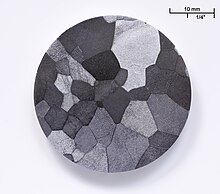 Type: Trace Element
Type: Trace Element
Periodic Element: (V)
RDA:None listed. Tolerable Upper Intake Level (UL) of dietary vanadium, beyond which adverse effects may occur, is set at 1.8 mg/day.
Importance- To Body:
(Not Considered Essential)
Distribution- In Body:
* Approx. % of Body Mass
Dietary intake is estimated at 6 to 18 µg/day, with less than 5% absorbed. The Tolerable Upper Intake Level (UL) of dietary vanadium, beyond which adverse effects may occur, is set at 1.8 mg/day
Vanadium compounds are poorly absorbed through the gastrointestinal system.
Excess Effects:
Effects have been reported after oral or inhalation exposures on blood parameters, liver, neurological development, and other organs in rats.
Deficiency Effects:
Deficiencies in vanadium result in Reduced Growth in rats, (application to human physiology unknown).
Sources Food:
None listed
Sources Environmental/Geographic:
The vanadyl ion is abundant in seawater, having an average concentration of 30 nM. Some mineral water springs also contain the ion in high concentrations. For example, springs near Mount Fuji contain as much as 54 μg per liter.
The cosmic abundance of vanadium in the universe is 0.0001%, making the element nearly as common as copper or zinc.
Supplemental information:
All vanadium compounds should be considered toxic.
 |
||||||||||||||||||||||||||||
| General properties | ||||||||||||||||||||||||||||
|---|---|---|---|---|---|---|---|---|---|---|---|---|---|---|---|---|---|---|---|---|---|---|---|---|---|---|---|---|
| Pronunciation | /vəˈneɪdiəm/ |
|||||||||||||||||||||||||||
| Appearance | blue-silver-grey metal | |||||||||||||||||||||||||||
| Standard atomic weight (Ar, standard) | 50.9415(1) | |||||||||||||||||||||||||||
| Vanadium in the periodic table | ||||||||||||||||||||||||||||
|
||||||||||||||||||||||||||||
| Atomic number (Z) | 23 | |||||||||||||||||||||||||||
| Group | group 5 | |||||||||||||||||||||||||||
| Period | period 4 | |||||||||||||||||||||||||||
| Element category | transition metal | |||||||||||||||||||||||||||
| Block | d-block | |||||||||||||||||||||||||||
| Electron configuration | [Ar] 3d3 4s2 | |||||||||||||||||||||||||||
|
Electrons per shell
|
2, 8, 11, 2 | |||||||||||||||||||||||||||
| Physical properties | ||||||||||||||||||||||||||||
| Phase at STP | solid | |||||||||||||||||||||||||||
| Melting point | 2183 K (1910 °C, 3470 °F) | |||||||||||||||||||||||||||
| Boiling point | 3680 K (3407 °C, 6165 °F) | |||||||||||||||||||||||||||
| Density (near r.t.) | 6.0 g/cm3 | |||||||||||||||||||||||||||
| when liquid (at m.p.) | 5.5 g/cm3 | |||||||||||||||||||||||||||
| Heat of fusion | 21.5 kJ/mol | |||||||||||||||||||||||||||
| Heat of vaporization | 444 kJ/mol | |||||||||||||||||||||||||||
| Molar heat capacity | 24.89 J/(mol·K) | |||||||||||||||||||||||||||
Vapor pressure
|
||||||||||||||||||||||||||||
| Atomic properties | ||||||||||||||||||||||||||||
| Oxidation states | 5, 4, 3, 2, 1, −1, −3 |
|||||||||||||||||||||||||||
| Electronegativity | Pauling scale: 1.63 | |||||||||||||||||||||||||||
| Ionization energies |
|
|||||||||||||||||||||||||||
| Atomic radius | empirical: 134 pm | |||||||||||||||||||||||||||
| Covalent radius | 153±8 pm | |||||||||||||||||||||||||||
|
||||||||||||||||||||||||||||
| Miscellanea | ||||||||||||||||||||||||||||
| Crystal structure | body-centered cubic (bcc) | |||||||||||||||||||||||||||
| Speed of sound thin rod | 4560 m/s (at 20 °C) | |||||||||||||||||||||||||||
| Thermal expansion | 8.4 µm/(m·K) (at 25 °C) | |||||||||||||||||||||||||||
| Thermal conductivity | 30.7 W/(m·K) | |||||||||||||||||||||||||||
| Electrical resistivity | 197 nΩ·m (at 20 °C) | |||||||||||||||||||||||||||
| Magnetic ordering | paramagnetic | |||||||||||||||||||||||||||
| Magnetic susceptibility | +255.0·10−6 cm3/mol (298 K) | |||||||||||||||||||||||||||
| Young's modulus | 128 GPa | |||||||||||||||||||||||||||
| Shear modulus | 47 GPa | |||||||||||||||||||||||||||
| Bulk modulus | 160 GPa | |||||||||||||||||||||||||||
| Poisson ratio | 0.37 | |||||||||||||||||||||||||||
| Mohs hardness | 6.7 | |||||||||||||||||||||||||||
| Vickers hardness | 628–640 MPa | |||||||||||||||||||||||||||
| Brinell hardness | 600–742 MPa | |||||||||||||||||||||||||||
| CAS Number | 7440-62-2 | |||||||||||||||||||||||||||
| History | ||||||||||||||||||||||||||||
| Discovery | Andrés Manuel del Río (1801) | |||||||||||||||||||||||||||
| First isolation | Nils Gabriel Sefström (1830) | |||||||||||||||||||||||||||
| Named by | Nils Gabriel Sefström (1830) | |||||||||||||||||||||||||||
| Main isotopes of vanadium | ||||||||||||||||||||||||||||
|
||||||||||||||||||||||||||||
Vanadium is a chemical element with symbol V and atomic number 23. It is a hard, silvery grey, ductile, and malleable transition metal. The elemental metal is rarely found in nature, but once isolated artificially, the formation of an oxide layer (passivation) stabilizes the free metal somewhat against further oxidation.
Andrés Manuel del Río discovered compounds of vanadium in 1801 in Mexico by analyzing a new lead-bearing mineral he called "brown lead", and presumed its qualities were due to the presence of a new element, which he named erythronium (derived from Greek for "red") since, upon heating, most of the salts turned red. Four years later, however, he was (erroneously) convinced by other scientists that erythronium was identical to chromium. Chlorides of vanadium were generated in 1830 by Nils Gabriel Sefström who thereby proved that a new element was involved, which he named "vanadium" after the Scandinavian goddess of beauty and fertility, Vanadís (Freyja). Both names were attributed to the wide range of colors found in vanadium compounds. Del Rio's lead mineral was later renamed vanadinite for its vanadium content. In 1867 Henry Enfield Roscoe obtained the pure element.
Vanadium occurs naturally in about 65 different minerals and in fossil fuel deposits. It is produced in China and Russia from steel smelter slag; other countries produce it either from the flue dust of heavy oil, or as a byproduct of uranium mining. It is mainly used to produce specialty steel alloys such as high-speed tool steels. The most important industrial vanadium compound, vanadium pentoxide, is used as a catalyst for the production of sulfuric acid.
Large amounts of vanadium ions are found in a few organisms, possibly as a toxin. The oxide and some other salts of vanadium have moderate toxicity. Particularly in the ocean, vanadium is used by some life forms as an active center of enzymes, such as the vanadium bromoperoxidase of some ocean algae.



